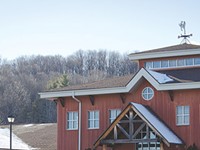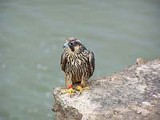[
{
"name": "500x250 Ad",
"insertPoint": "5",
"component": "15667920",
"parentWrapperClass": "",
"requiredCountToDisplay": "1"
}
]
Not 10 minutes after I stepped onto the pedestrian bridge at High Falls, a Peregrine Falcon swooped up from the falls side of the bridge and made a breathtaking flyover. "It's Hafoc," said one of the regular falcon watchers, not even raising his binoculars. The bird was barely eight feet above us --- close enough to see individual feathers and the bird's blue leg-band. Before the Kodak falcon project, I'd seen only a half-dozen Peregrines in a lifetime, and most of them at a distance, so the moment brought a sudden rush of fulfillment. The bird of kings was before us, at the Pont de Rennes, Rochester, New York, at our own High Falls, three minutes away from Rochester's four corners. The conditions for observation are the very best --- steady footing surrounded by a rock-walled amphitheater carved over a period of 12,000 years by the rushing waters of the Genesee River.
You know us falcon watchers by our optics --- binoculars, spotting scopes, cameras. Luckily, I'd kept my 7X35s in the car for just such an occasion.
As we speak, if it's daylight, one or more of the seven Rochester Peregrine Falcons may be in view from the High Falls pedestrian bridge. If they're not flying, they could be perched nearby. The two parents, Mariah and Kaver, have dark slatey-gray wings and backs, distinctive black patches on the sides of their white throats, white breasts, and finely barred bellies and upper leg feathers. And let's not forget the feet --- big yellow feet with scimitar-like talons --- the Peregrine's weapons of the hunt.
The juveniles, until recently residents of the breeding box on Kodak's corporate tower, have a browner appearance --- black streaks over buff --- with less distinct markings overall. But also big yellow feet.
You can tell who's who among the juveniles by the colored bands on their right legs. Pride, a female, has a red band; Gahastey, a female, a yellow band; Alkyonis, another female, a white band. Hafoc, the larger of the two males, has a blue band, and Grissom, the other male, a green band. The colored tape was applied over US Fish and Wildlife Service bands and will wear off eventually, leaving all the birds with black USFWS bands on their right legs. The bands on the left legs were put on by the NY State Department of Environmental Conservation --- red/black on females, green/black on males.
At the pedestrian bridge you're in the middle of a giant diorama in pulsing 3-D, mega-pixel color, and 360° surround-sound --- the ultimate reality show.
Not just for Peregrines. In the 30 minutes I spent on the bridge I saw --- far below --- a White-tailed Deer, Mallard Ducks, Canada Geese (complete with a trailing fleet of goslings), two woodchucks, and a Great Blue Heron standing stalk-still on a rock. The heron had been dive-bombed earlier by one of the juvenile falcons --- just in fun. A duck and one of the woodchucks got the same treatment. It was the duck's lucky day because in a week or so it could be for real. Up till about 30 years ago, Peregrine Falcons were called Duck Hawks, because ducks make up a large part of their diet.
Also coursing brashly around the gorge was a feisty Kestrel, our smallest falcon species. With ultimate chutzpah, the little Kestrel was determined to protect its own recently fledged brood, and didn't hesitate to harass the larger Peregrines whenever they seemed to present a threat.
The young Peregrine Falcons are full of the juice of discovery, practicing their new-found aeronautical skills for what they most famously do --- pursue, dive on, and stun prey, usually in mid-air.
For a couple of weeks after fledging (growing flight feathers), the five juveniles looked to the parent birds for their meals --- delivered to ledges on the Kodak Office tower. The riskiest phase came during the transition from nest box to the limitless sky. To shepherd the fledglings through this iffy stage, a Fledgling Watch was organized by June Summers, president of the Genesee Valley Audubon Society, to look out for the young birds --- as they flopped, fluttered, and tumbled, to lower tiers on the tower, and some to the ground below. Watch members were given special training, supervised by a veterinarian, on the techniques of befriending young falcons --- how to remove them from harm's way, where to take them if they seemed to be hurt, and how to avoid injury from their sharp beaks and claws.
Marcia Lyman is an experienced Fledge Watcher and has a store of anecdotes about the young --- and sometimes foolish --- birds, collected as she and her teammates tried valiantly to maintain a running "beak count" of the new brood. One day she watched, helpless, as Hafoc tried to land on a sloping Kodak roof. The surprised bird slid ignominiously all the way to the bottom, but reappeared shortly afterward none the worse for the experience. Brian Hearne is another dedicated watcher --- found often on the pedestrian bridge and always willing to share the latest news.
This year, two of the young birds, Grissom and Alkyonis, were rescued by Fledge Watchers, one of whom was Jim Pisello, the photographer for this article. Found on the ground in precarious circumstances, the birds were taken to the project veterinarian who kept the birds for a few days, making sure they are healthy and well fed, and strong enough to resume their flight plans. When OK'd for release, their sibling and parents welcomed them back with an enthusiastic show of aerial talent. And a few days later, Alkyonis was again rescued, from a stroll along the pavement of East Main Street.
When the juveniles are flying on their own, the parents help them learn to hunt by dropping food in mid-air. Seeing the falling prey, the young birds dive and snatch it for a meal.
By now, in mid July, the young birds are all flying and hunting, mostly on their own. For a few weeks they will stay close to home, then they'll stray farther and farther up and down the Genesee River gorge until in mid-August they will leave the area for parts unknown. Peregrine, in fact, means wanderer. After the diaspora, the likelihood of seeing falcons from the pedestrian bridge --- juveniles or adults --- diminishes markedly. So carpe diem!
Peregrine Falcons are beautiful birds by any measure, but much of their appeal derives from their power and lethal grace. They fly with a disarming silkiness, so effortlessly they seem hardly to be trying.
Animal rights advocates may be understandably ambivalent about our efforts to build back the once-endangered Peregrine Falcons' populations. If we did to birds what falcons do to birds, we'd be locked up for animal cruelty. Watching a falcon rip apart a pigeon on a window ledge is not a gentling experience. Falcons get away with it because it's Nature's way, and it is. Falcons have been catching birds and other prey for millions of years, and it's not likely that their feeding habits will change in the future.
I was curious about the official stance of animal rights activists on natural predators, so I sent an e-mail to PETA, People for Ethical Treatment of Animals, asking for their official position on Peregrine repopulation. Spokeswoman Stephanie Boyles said PETA applauds the Kodak falcon project, and others like it, that have helped bring the Peregrine Falcon back from the brink of extinction.
For some falcon watchers, seeing a strike in mid-air is the peak experience. One reason is simply the visual excitement --- the power dive is breathtaking and so distinctive it has a special name, the stoop. This has always been the climactic moment of falconry. The speed of a Peregrine Falcon in mid-stoop has been estimated at "between 100 and 200 miles per hour," which would make it the fastest bird on earth. But the wide range given belies the accuracy of the numbers. How would one measure such an unpredictable and transitory event?
Historically, falconry --- hunting small game with trained falcons --- has been reserved for royalty, hence the term "sport of kings." Possession of falcons by commoners was forbidden. In this country, possession of falcons, or any hawks, by anybody, is illegal without a special license. Peregrine Falcons are not the only hawks used for falconry, but they've always been top choice because of their dash and power.
All falcons are classy birds. The little Kestrels (formerly called Sparrow Hawks) whip around in fine style. Falcons act as if they know what they're doing. They're very confident --- in that sense, regal, in command.
Juvenile Peregrines like to play --- swooping, darting at each other, chasing each other about, pursuing butterflies and falling leaves, tumbling in pairs with talons interlocked, honing their aerial skills. It's a good show. But even if you only see one bird from the bridge, and that one is perched, it will have been well worth the effort.
Legally, the Kodak Peregrine Falcons are wards of New York State. They're also protected by federal law. Having made a comeback from near extinction due to DDT in the food chain --- which made their eggs too fragile for incubation --- the birds have been removed from the federal endangered species list, but are still considered endangered by the New York State Department of Environmental Conservation.
This is the sixth year for the Kodak Falcon Project. It was started in 1998 by Dennis Money, environmental analyst for Rochester Gas and Electric. The nest box and cameras are now maintained by Kodak in close cooperation with the DEC --- a member of which participated in the banding on June 4. Money also spearheaded the successful Western-Central New York River Otter Restoration Project.
Even after the falcon family disperses in late summer, we may still be able to keep track of Hafoc. He has a transmitter harnessed to his back that sends signals to a satellite, thence to trackers who hope to learn more about the migration of male Peregrines. Many juvenile falcons simply disappear off the radar screen, never to be seen again. The first-year attrition rate is pretty high, mostly from crashing into things during migration. One of last year's brood, Isaura, apparently had a fatal collision with an airplane. She was found dead near an airport runway. All we can do is wish the new brood good luck and look for parents Mariah and Kaver to be back next spring.
Falcon watchers come from other states, other continents. And those who don't actually come regularly check out the Kodak Birdcam website's discussion board. To date, in 2004, there have been more than 23,000 postings. With the birds flown, the discussion board shuts down July 21. To check it out again next March, Google for "Kodak Birdcam 2005."
So get out on the bridge and take advantage of this special opportunity. Falconeers are a friendly bunch, and watching falcons is a social event. Just walk up to somebody with binoculars and ask, "What's happening?" You'll be clued in to the latest action. Let us know what you see.
Speaking of Peregrine Falcons, High Falls
-

Former RG&E plant could become falls overlook
Jan 8, 2020 -

Work progressing at MCC's future home
May 3, 2016 -

On the streets where you live
Mar 27, 2013 - More »
Latest in Culture
More by Warren Wightman
-

Will Shortz is not a fiend
Dec 14, 2005 -

A concise handbook of astrology
Dec 11, 2002 - More »



